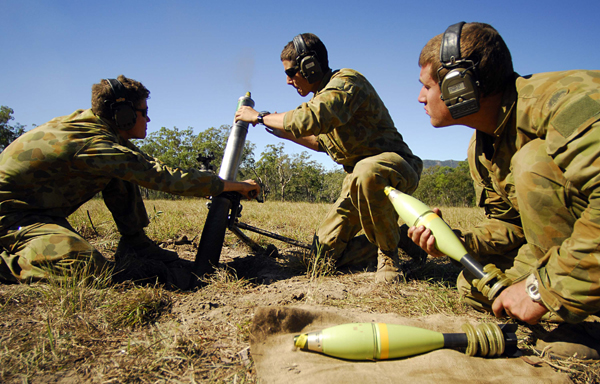When is off the shelf not off the shelf? When it takes an age for the shopper to decide that he wants a little from product A and a little from product B. A great example of this would be the Commonwealth’s efforts to equip the Army with a 40mm light weight automatic grenade launcher (LWAGL) under project Land 40 Phase 2, which kicked off in earnest in 2007. The aim was for an off-the-shelf product, but the process that followed was highly questionable.
It started with the program office conducting market research and examining various contracting models, to come down to two off-the-shelf contenders. It seems that the Commonwealth was essentially keen on the barrel from one product and the sight from another, but neither company was keen on this approach.
Fast forward to 2013, and more has been spent on the process than the 60 guns would have cost to procure in the first place. Along the way ‘off-the-shelf’ seems to have been loosely interpreted, and the Defence Science and Technology Organisation also weighed in with a Science and Technology Plan. No wonder a Project of Concern flag was raised and the program, as it then stood, was cancelled in April this year.
Another example is project Land 136 for a replacement mortar system. After going to market twice to see what local industry could offer, the Commonwealth has decided to buy American through the Foreign Military Sales (FMS) system. Any Australian Industry Capability (AIC) elements will be post-purchase with training and through life support. (AIC plans come into play with programs over $20 million and Land 136 has been capped at $100 million.)
I get the feeling that the procurement process, other than the rapid acquisition framework, is broken. The Force Protection measures instigated by former Defence Minister Senator John Faulkner were a direct result of his experience in being with front line troops in Afghanistan. This lit the metaphorical fire under the process, burning away a lot of the dead paper involved to get soldiers the equipment they needed.
It takes, on average, about a decade for a project to enter the Defence Capability Plan (PDF) and to be delivered. I’ve joked with many industry folk, and even a few from DMO, that there’s enough paperwork and associated bureaucratic hurdles involved that one could papier-mâché the capability into being much more easily. We all had a giggle at the mental image of a paper defence force. But the joke has stopped being funny.
There are a host of measures, reviews and frameworks to try and make the process better, and some of them are even working. The tight budgetary environment has a way of focusing people as well. DMO CEO Warren King has often spoken of trying to foster an environment of ‘managed urgency’ into his organisation. There’s still a lot of the former and not much of the latter, although cultural change takes time to trickle through organisations.
The UK has just released a report into their version of the DMO, Defence Equipment and Support (DE&S), and what could be done to make it a more effective organisation. In releasing the report, Secretary of State for Defence, Philip Hammond said ‘Great progress has already been made, but if we are to maintain a balanced budget and continue to provide a better service to the front-line, we must make real changes to our Defence Acquisition systems—tinkering at the edges is not enough’.
The new UK White Paper sets out the background to the proposed changes, both to the structure of DE&S, and to the single-source procurement regime, as well as the legislative requirements that will be needed to make those changes operational:
- creating a new Government-Owned Contractor Operated (GOCO) operating model to manage the procurement and support of defence equipment by the Defence Equipment and Support. This will bring in incentivised private sector expertise to improve the delivery of the MOD’s equipment program by introducing systems and ways of working that provide staff with the best access to the necessary skills, processes and tools to enable them to do their jobs better, driving value for money in equipment projects
- creating a new statutory framework to ensure transparency and to encourage efficiency in single-source procurement contracts. This will provide an assurance that value for money is being obtained for the taxpayer in this significant area of MOD business.
Hammond added: ‘A radical improvement in the ability of the whole of MOD to set requirements and deliver equipment, ‘right first time’, is needed if the Department is to be able to continue to deliver an Equipment Program of roughly the same size and complexity, year on year with 28% fewer people (the reduction required by the 2010 SDSR)’.
Australia faces many of the same circumstances as the UK in terms of people and budget pressures. It’s time to stop tinkering at the edges and make some meaningful changes in the Australian Defence procurement landscape.
Does this mean the wholesale replacement of the DMO with a private agency is the way forward? I don’t think there’s an appetite or even a need for such measures here. But the results of a range of programs, both acquisition and sustainment, have made it increasingly clear that some massive changes are required to get the performance that the ADF needs at a price the taxpayer can afford.
Katherine Ziesing is the Editor of Australian Defence Magazine, an independently published magazine on Defence capability and procurement. She is also a board member of the Sir Richard Williams Foundation, an air power think tank. Image courtesy of Australian Department of Defence.


